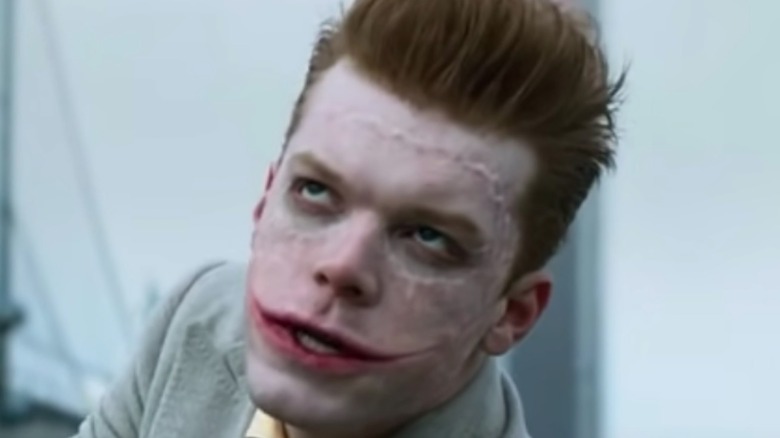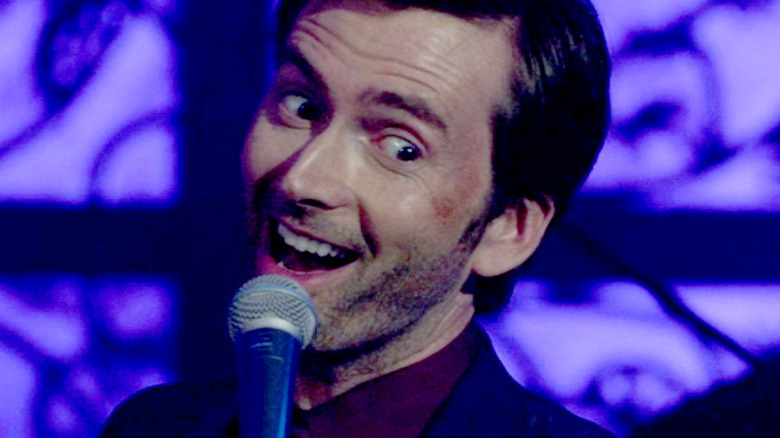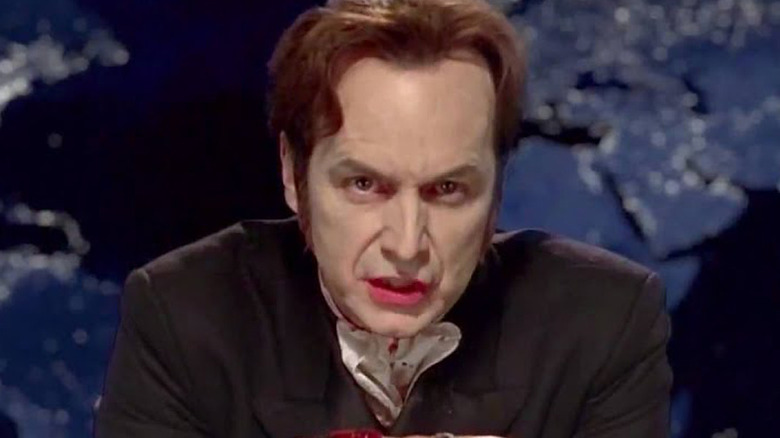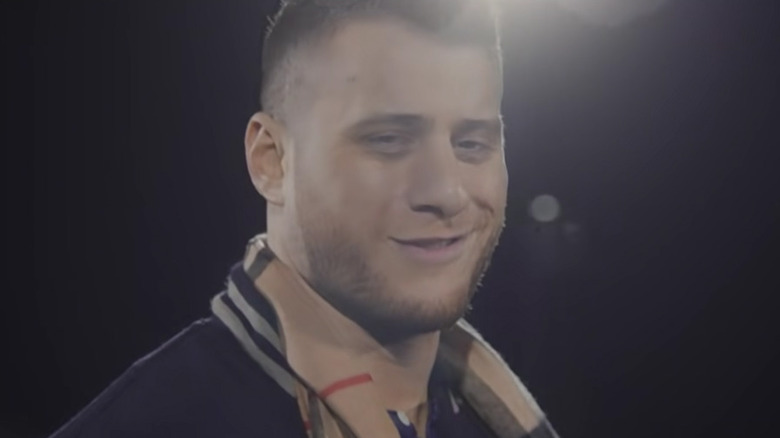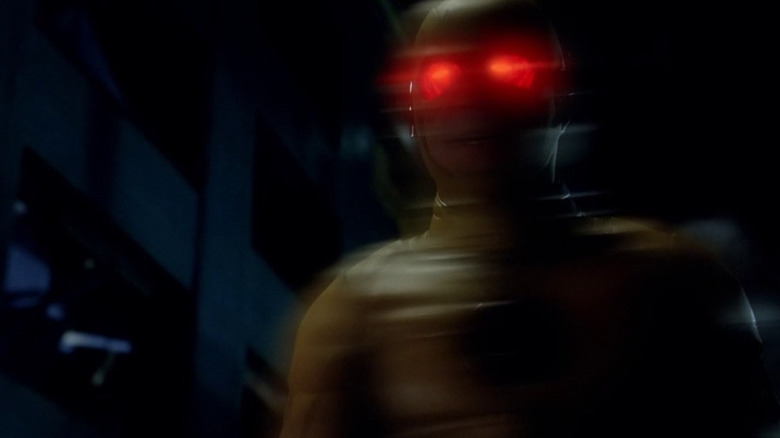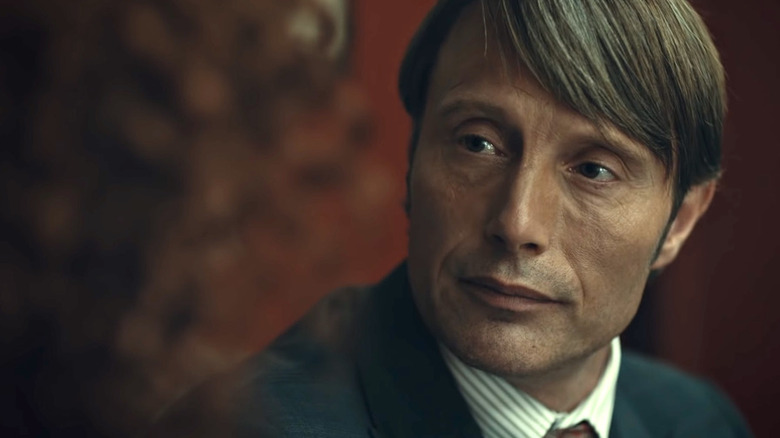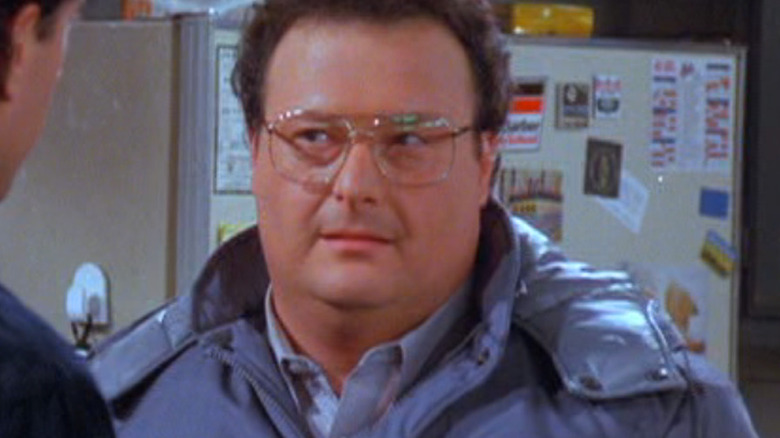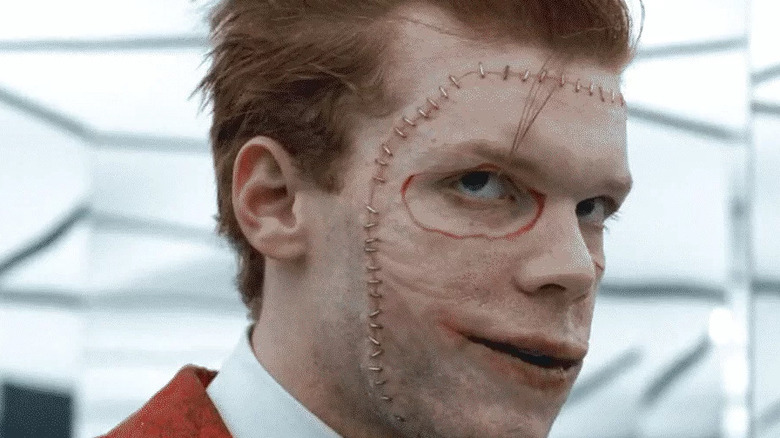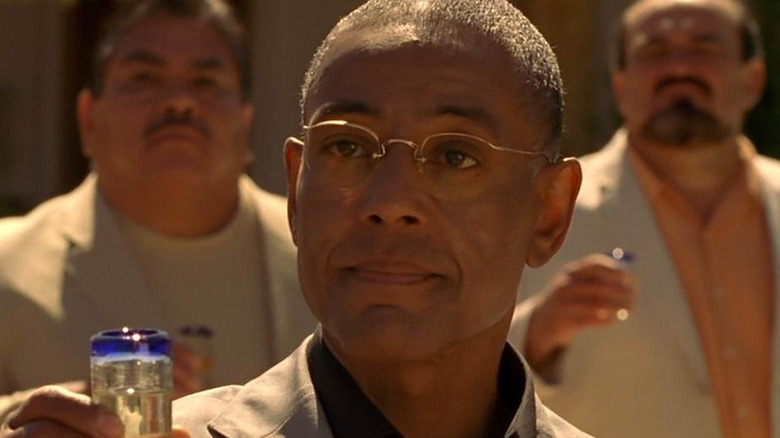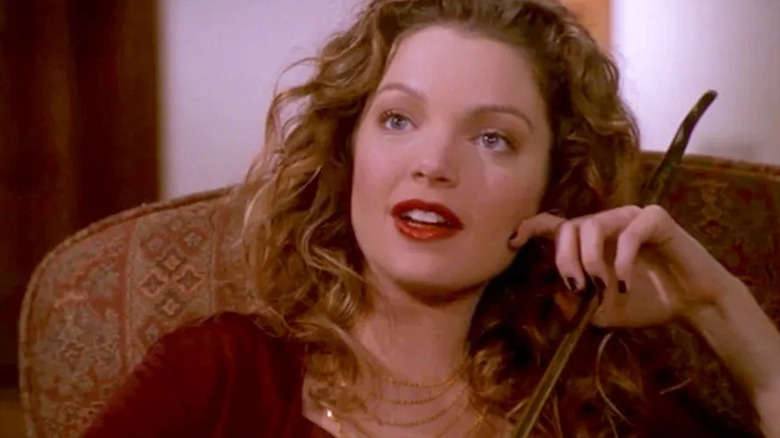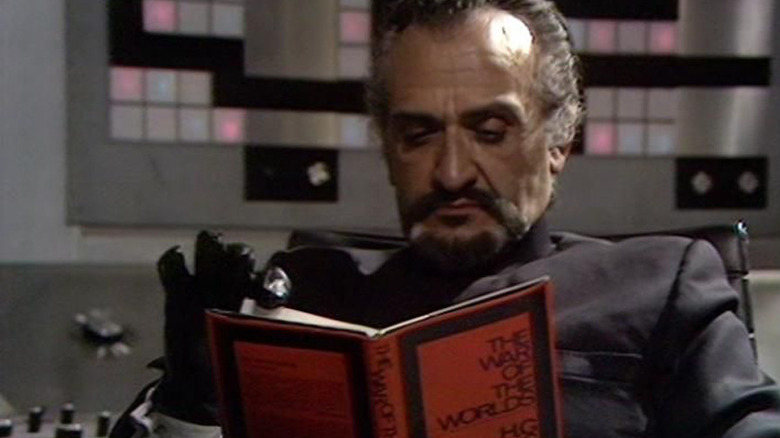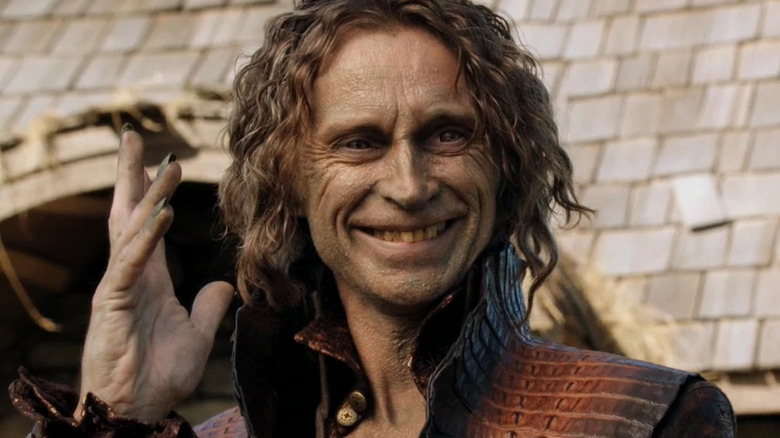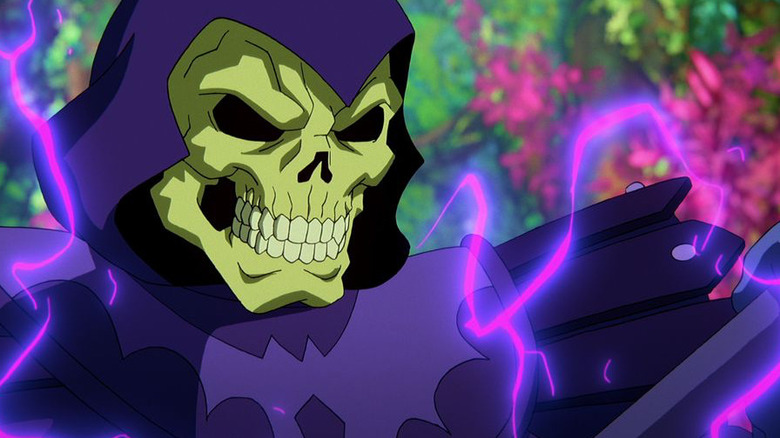TV Characters We Love To Hate
In the world of fiction, emotional investment is everything, so if you can't make your characters interesting enough, the narrative will likely fail. Throughout countless television shows over the years, there have always been virtuous heroes, morally gray protagonists, and morally detestable villains. However, there exists an interesting subgroup for a very specific type of character — those we love to hate. Whether it be a killer with a moral compass or a classic mustache-twirling villain, there's always something magnetic about them.
We've seen it recently with characters like John Kreese from "Cobra Kai" and as far back as Agent Smith in "The Matrix." Whether it's the way they're written or the actor's performance, there are many loathsome characters you can't help but connect with. Here are some characters that — despite their broken moral compass — possess an undeniable appeal.
Killgrave — Jessica Jones
The Marvel Netflix shows were a truly welcome oddity in the midst of great change for the Marvel Cinematic Universe. Far removed from the CGI-heavy and often high-concept presentation of their cinematic releases, these shows were an entirely different breed. "Daredevil" set the precedent with its gritty noir tone and darker storytelling and was followed up with "Jessica Jones." Based on the Marvel comic "Alias," the series had many standout qualities and performances — most notably its lead Krysten Ritter as Jessica. Jones is a bitter and frequently drunk private investigator who utilizes a set of superhuman abilities acquired in a traumatic childhood incident. She had tentative dreams of superheroing, but they were quickly destroyed by the sinister and controlling Zebediah Killgrave (David Tennant).
Using his superhuman ability of mind control, Killgrave horrifically held Jessica under his control for months. After escaping, Killgrave is a constant source of stress and trauma for her. Throughout Season 1, we get to see just how sadistic Killgrave actually is, helped in no small part by his own messed-up childhood. Tennant, best known for playing the 10th incarnation of "Doctor Who," brings every ounce of snide arrogance and sadistic humor to the role. Even after his death in Season 1, he still manages to be a lingering presence in Jessica's life, resulting in a few posthumous cameos.
Russell Edgington — True Blood
During the late '00s and 2010s, the vampire renaissance brought on by the wild successful "Twilight" franchise was inescapable. Countless studios and networks leaned into the heavy saturation of vampiric media, resulting in a barrage of different shows and movies. One such example of this trend is the HBO series "True Blood," the small screen adaptation of Charlaine Harris' "Southern Vampire Mysteries" novels. The novels and shows are a Southern-fried look into a world where vampires have revealed themselves to the world. Amidst this cultural transition, we meet Sookie Stackhouse (Anna Paquin), who begins a relationship with vampire Bill Compton (Stephen Moyer).
Throughout the show's six-season run, the duo — along with their friends and allies — encounter many different threats. In Season 3, we are introduced to Russell Edgington (Denis O'Hare), the Vampire King of Louisiana. O'Hare is a whirlwind of sadistic charisma, from his introductory scene to his last appearance in Season 5. Not only does he complicate Sookie and Bill's romantic relationship, but hundreds of years earlier, he killed Eric Northman's (Alexander Skarsgård) family. One of his standout moments is a long sinister monolog delivered on the evening news immediately after ripping an anchor's spine out. In a series that's filled to the brim with over-the-top characters, Russell Edgington is a cut above the rest.
Maxwell Jacob Friedman — All Elite Wrestling
In the world of professional wrestling, there are babyfaces and heels — the good guys and the bad guys. Much like in a comic book or a movie, the battle of good and evil is often the lynchpin of any pro wrestling show. However, in the modern era, things have gotten far murkier, as nowadays it's common to cheer for the bad guys. This has carried forward into the modern age, where a clear-cut babyface or heel getting the intended reaction is a rarity. All Elite Wrestling is no stranger to this, but there is one member of its roster who is challenging this development: Maxwell Jacob Friedman.
After a meteoric rise through the independent wrestling scene, the young upstart found himself signed by AEW in early 2019. In record time, MJF established himself as the smarmiest and smuggest heel of the modern age. Through his verbal tact, good looks, and significant wealth, MJF has had the AEW audience eating out of the palm of his hand. When MJF's music hits on a Wednesday night, you can expect a chorus of jeers and boos will follow shortly after. From Cody Rhodes to Darby Allin to the recently debuting CM Punk, young Maxwell has ruffled many feathers and shows zero sign of slowing down.
Reverse Flash — The Flash
DC Comics has produced dozens of memorable villains over its decades-long existence, and many heroes have a heavily populated rogues' gallery. While Batman's main antagonists might reign supreme in terms of popularity, there are many other sinister baddies in the DC Universe. One villain that didn't quite get his due until the last few years is Eobard Thwane, also known as the diabolical Reverse-Flash. While the character is a frequent threat in the world of the printed page and animation, he didn't get widespread attention until 2014 thanks to his appearance in the inaugural season of CW's "The Flash," the first major spin-off of "Arrow."
First introduced operating under the stolen identity of Dr. Harrison Wells, Thawne alters the timeline to expedite Barry's origin story. Acting as Barry's support and mentor, he puppeteered the Scarlet Speedster's development — a deceptive means to an end. Tom Cavanagh has never once wavered in his portrayal of the character, infusing it with equal parts menace and manic energy. Despite the show's wavering quality in recent seasons, whenever the Reverse Flash shows up, the storytelling quality immediately picks up. At the end of the day, the Reverse-Flash will always be fondly remembered as a truly memorable villain for the first year of "The Flash."
Hannibal Lecter — Hannibal
For years, many associated Hannibal Lecter with the great Anthony Hopkins due to his incomparable performance in "Silence of the Lambs." This changed when the show "Hannibal" hit the airwaves in the 2010s, introducing the world to another rendition of cinema's classiest cannibal. This time, Dr. Lecter was portrayed by Mads Mikkelsen, who played Le Chiffre in "Casino Royale." In the series, Lecter is first presented as a psychiatrist sought out by the FBI for assistance on a serial killer case.
It's soon shown that Hannibal is a killer in his own right — in the inaugural episode, he prepares a meal from someone's lungs. Throughout the series, we get to see just how coordinated, intelligent, and utterly ruthless this version of Hannibal can be. Indeed, the character is presented to be such a suave and charming person that his actions are all the more shocking. Despite his heinous activities, you can't help but be drawn to him due to his composed charm and culinary tact. It helps that this version of Hannibal has a great foil to work off of: FBI agent Will Graham, played by Hugh Dancy. The duo's chemistry truly is the glue that holds the show together and keeps fans coming back for more.
Newman — Seinfeld
In the pantheon of syndicated sitcoms, there are very few that have reached the heights of "Seinfeld." The show follows Jerry Seinfeld traversing life in New York City with the help of his friends — Elaine Benes, Cosmo Kramer, and George Costanza. The brainchild of Larry David and Jerry Seinfeld, the series is frequently described as "the show about nothing." This, of course, is not entirely true, as "Seinfeld" is indeed about something — small things and unspoken social rituals. The crux of the average "Seinfeld" episode is Jerry with one of his friends in tow in a mundane social circumstance. From waiting for a table at a Chinese restaurant to being stuck in an immense parking garage, the show tackles it all.
In that same spirit, Newman (Wayne Knight) is a comedic look at the stereotypically annoying NYC apartment tenant. In a show packed to the brim with expertly timed comedic performances, Knight is a gem in every one of his scenes. From his overly sophisticated line delivery to his general smarminess, it's no wonder Jerry loathes his very existence. Still, it can't be denied that his character brings a welcome dose of conflict to his appearances, which results in major laughs.
Jerome Valeska — Gotham
"Gotham" is a show that goes through a staggeringly bizarre transformation over the course of its half-decade long run. What starts off as a moderately grounded look at the early days of Gotham City quickly undergoes an insane transformation. The series eventually takes a dose of insanity gas and borrows more qualities from high-concept comic books. Nowhere is this transition more evident than with the character of Jerome Valeska, played by Cameron Monaghan (better known as Ian from "Shameless"). The character's introduction swerves you by making you think a young Jerome Valeska is a timid and meek mama's boy. This is quickly proven to be a devious facade, as in actuality, Jerome is a gleefully sadistic psychotic killer who recently killed his own mother. From here, Jerome moves on from small personal vendettas to becoming one of Gotham City's most feared criminal masterminds.
Jermone's often chaotic criminal machinations have significant effects on both Bruce Wayne and Jim Gordon's lives. Over the course of the show's first four seasons, Jerome lives free, dies young, is resurrected, and then subsequently dies again. The character obviously shares a lot of similarities to other Jokers in both his appearance and level of insanity, but Monaghan's performance is youthful and distinctive enough to give his version its own identity.
Gus Fring — Breaking Bad
Gustavo Fring (Giancarlo Esposito) is first introduced in the 2nd season of "Breaking Bad," instantly establishing himself as a force not to be trifled with. In his introductory scene, we see him transition between his cheerful facade as a fried chicken restaurateur to a cold and calculating kingpin. Throughout the show's 2nd, 3rd, and 4th seasons, Gus serves as the biggest threat to Walter and Jesse. He consistently maintains a callus and composed demeanor even when carrying out the most heinous of actions. The infamous box cutter scene from the Season 3 premiere episode will always go down as one of TV's most viscerally shocking moments, and his death in the conclusion of Season 4 at the hands of a homemade wheelchair bomb even more so!
His chemistry with the likes of Bryan Cranston and Aaron Paul is impeccable, elevated by the stellar writing of Vince Gilligan. Esposito's onscreen presence is undeniable, resulting in several standout scenes where you simply cannot take your eyes off him. There is something magnetic about his subdued delivery that instantly makes you hang off of his every word. With a cold stare and very little remorse, Gus Fring is truly a cut above the rest and one of TV's finest villains.
Glory — Buffy the Vampire Slayer
"Buffy the Vampire Slayer" will forever remain an endearing part of geek culture, and it isn't hard to see why. The show's endlessly quotable dialogue mixed with its high-concept blend of comedy and horror resulted in a legion of dedicated fans. However, while Buffy and her friends were always the main attraction, we can never forget the show's roster of memorable villains. Over the course of its seven-season run, Buffy squares off with many dastardly foes, but quite possibly the best was Glory. Glorificus, or Glory for short, is first introduced in the show's 5th season and immediately stands out as a different kind of villain.
While the show had seen its share of villains with a comedic slant — Mayor Wilkins is a prime example — Glory was far different. After being forced into the mortal realm via the body of a young Benjamin Wilkinson, Glory begins manifesting for longer and longer. But despite being an ancient goddess, she takes on the form of a snobby and self-centered valley girl. Through a combination of her often despicable actions and her vain personality, Glory maintains an unorthodox yet undeniable charm. From her first moments onscreen, Clare Kramer absolutely devours every scene she's in and has ample chemistry with the entire cast.
The Master — Doctor Who
The Doctors have seen many threats over the course of their decades-long adventures throughout time and space, from the destruction of the Daleks to the cold calculations of the Cybermen. But all pale in comparison to the Master. First introduced during the Third Doctor's (Jon Pertwee) era, the first incarnation of the Master is played by Roger Delgado. The character is originally portrayed as the dark inverse of Doctor Who, equally as clever but with zero moral compass. The duo shares an undeniably complicated relationship — much like Sherlock Holmes and James Moriarty— and they possess both mild respect and undeniable hatred for each other. Despite the character's many reboots over the years, one quality that always persists is his absurd intelligence and often egomaniacal charm.
After Delgado's untimely passing in 1973, the character is regenerated in subsequent appearances, much like the Doctor. The character reemerges a few times, often boasting a deformed and zombie-like appearance — a clever way to justify a new actor. Following this, the character is played by Anthony Ainley up until the original series' conclusion. In the modern era of "Doctor Who," the character is played by Derek Jacobi, John Simm, Michelle Gomez, and Sacha Dhawan, and all bring something new and unique to the table. As long as the Doctor continues to write wrongs throughout time and space, the Master will likely always be there to cause conflict.
Rumpelstiltskin — Once Upon A Time
In a show packed with as many quality villains as "Once Upon a Time," standing out as the best is quite the challenge. Nevertheless, the character of Rumpelstiltskin (Robert Carlyle) proves to be one of the series' most endearing characters over its seven-season run. He was first introduced in Season 1 as the creator of the Dark Curse — the catalyst of the entire series that transports everyone to Storybrooke. Throughout the inaugural season and onward, Rumple, as he is often referred to, becomes an integral part of the ongoing narrative. Along the way, almost every main character becomes a part of his hidden machinations in some form or another.
His backstory is rife with betrayals, curses, lost love, and revenge, and it makes for some of the show's most compelling material. A major example of this is a quasi-retelling of "Beauty and the Beast" told with Rumple and his love interest Belle (Emilie de Ravin). Despite often having a secret scheme or agenda, Rumple proves himself to be capable of love and performing great sacrifice. It also helps that Carlyle's on-screen charisma is off the charts, balancing humor and menace with equal tact.
Skeletor — He Man and the Masters of the Universe
He's the epitome of the cheesy '80s cartoon villain whose original genesis spawned from a desire to sell action figures. Skeletor, the Evil Lord of Destruction, has been the main antagonist of the "He-Man" franchise since its creation back in 1983. The character's origins are quite fascinating, and while he was developed to sell toys, Skeletor's creator has bizarre real-life influence. As mentioned by Mark Taylor in "The Toys That Made Us," Skeletor's design was influenced by a real human corpse at a children's carnival. Everything about the character— from his design to his nasal voice — is pure, unadulterated 1980s cheesiness, and it's an absolute delight.
There's a reason the character has been turned into various internet memes and spoofed on parody shows like "Robot Chicken." Simply put, he's as simple, vibrant, and entertaining as a Saturday morning cartoon villain can be. The character was voiced by Alan Oppenheimer in the original series and was recently given new life via Mark Hamill. In the recent "Masters of the Universe: Revelation" sequel series, Hamill brings his typically top-quality menace and charm to the role. It's nothing short of endearing to see a franchise and a villain so beloved that they have persisted to this very day.
